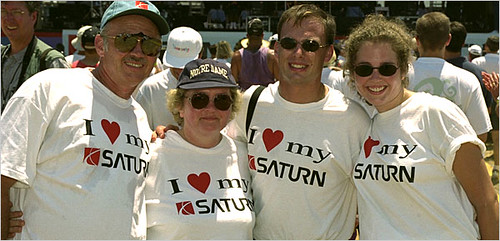A Different Kind of Car
[youtube=http://www.youtube.com/watch?v=kmDZGDMkBac&feature=player_embedded]
Brilliant TV spot from Hal Riney & Partners for Saturn, a modern marketing success — for a while at least. Too bad the brand may go away, joining the recently-departed Oldsmobile and Plymouth brands. I think the Saturn experience is different. A real sense of community was built around it — both natural and manufactured. Remember the Saturn Homecomings? With thousands of people showing up, some called it “Saturnstock.” Sadly, they’re a thing of the past now.

If you remember how exciting it was watching GM create a new brand in the late 80’s and early 90’s, then you simply must read Newsweek’s excellent piece on the topic:
Saturn was hardly a panacea. But its fall to earth, more than $5 billion in GM money later, is about far more than the flameout of one brand. In the eyes of some automotive analysts, Saturn represents a major missed opportunity for Detroit to place a sustained bet on fuel-efficient cars that would compete with the Japanese—and to recalibrate the bitter business-labor relationship in ways that could have had far-reaching implications for the entire industry. Saturn was never able to surpass the Japanese in technology, as Smith had hoped. But the competitive knives Saturn faced within GM did far more damage than any threat from overseas: execs who felt the auto giant already had too many brands and factories; dealers resentful of Saturn’s product-development dollars; and a labor union whose leadership came to regard the brand’s workplace innovations as collaborations with the enemy. It did not help matters that from the mid-1990s until just recently, Americans turned away from small cars in favor of trucks and SUVs.
How will this chapter of GM’s history be written?

